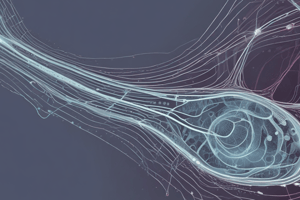Podcast
Questions and Answers
What is the primary function of the retina in the eye?
What is the primary function of the retina in the eye?
- To convert light into electrical signals and transmit them to the brain (correct)
- To absorb light and convert it into heat energy
- To produce tears to lubricate the eye
- To regulate the amount of light entering the eye
Which type of photoreceptor is responsible for peripheral and night vision?
Which type of photoreceptor is responsible for peripheral and night vision?
- Cones
- Rods (correct)
- Ganglion cells
- Bipolar cells
What is the role of Müller cells in the retina?
What is the role of Müller cells in the retina?
- To provide structural support to the retina (correct)
- To transmit signals to the brain
- To produce melatonin
- To regenerate photopigments
What is the term for the process by which light is absorbed by photopigments in the retina?
What is the term for the process by which light is absorbed by photopigments in the retina?
Which layer of the retina contains the cell bodies of bipolar cells, Müller cells, and horizontal cells?
Which layer of the retina contains the cell bodies of bipolar cells, Müller cells, and horizontal cells?
What is the neurotransmitter released by photoreceptors in the retina?
What is the neurotransmitter released by photoreceptors in the retina?
What is the term for the decrease in cGMP levels in photoreceptors after light absorption?
What is the term for the decrease in cGMP levels in photoreceptors after light absorption?
Which type of cell is responsible for transmitting visual information from the retina to the brain?
Which type of cell is responsible for transmitting visual information from the retina to the brain?
Flashcards are hidden until you start studying
Study Notes
Structure of the Retina
- The retina is a complex, multi-layered tissue lining the innermost aspect of the eye
- Composed of:
- Photoreceptors (rods and cones)
- Bipolar cells
- Ganglion cells
- Horizontal cells
- Amacrine cells
- Müller cells
Functions of the Retina
- Converts light into electrical signals
- Processes visual information
- Transmits signals to the brain via the optic nerve
Photoreceptors (Rods and Cones)
- Rods:
- Sensitive to low light levels
- Responsible for peripheral and night vision
- Have only one type of photopigment (rhodopsin)
- Cones:
- Responsible for color vision and high-acuity vision
- Three types of cones, each sensitive to different parts of the visual spectrum (red, green, blue)
- Found primarily in the central retina (fovea)
Signal Transmission in the Retina
- Phototransduction pathway:
- Light absorption by photopigments (rhodopsin or photopsin)
- Activation of transducin (G-protein)
- Decrease in cGMP levels
- Closure of Na+ channels
- Hyperpolarization of photoreceptors
- Signal transmission to bipolar cells
- Chemical synapse between photoreceptors and bipolar cells
- Release of glutamate from photoreceptors
- Activation of bipolar cells
Retinal Layers
- Outer plexiform layer: contains synapses between photoreceptors and bipolar cells
- Inner nuclear layer: contains cell bodies of bipolar cells, Müller cells, and horizontal cells
- Inner plexiform layer: contains synapses between bipolar cells and ganglion cells
- Ganglion cell layer: contains ganglion cell bodies and axons
- Nerve fiber layer: contains axons of ganglion cells
Structure of the Retina
- The retina is a complex, multi-layered tissue lining the innermost aspect of the eye
- Composed of photoreceptors, bipolar cells, ganglion cells, horizontal cells, amacrine cells, and Müller cells
Functions of the Retina
- Converts light into electrical signals
- Processes visual information
- Transmits signals to the brain via the optic nerve
Photoreceptors (Rods and Cones)
- Rods:
- Sensitive to low light levels
- Responsible for peripheral and night vision
- Have only one type of photopigment (rhodopsin)
- Cones:
- Responsible for color vision and high-acuity vision
- Three types of cones, each sensitive to different parts of the visual spectrum (red, green, blue)
- Found primarily in the central retina (fovea)
Signal Transmission in the Retina
- Phototransduction pathway:
- Light absorption by photopigments (rhodopsin or photopsin)
- Activation of transducin (G-protein)
- Decrease in cGMP levels
- Closure of Na+ channels
- Hyperpolarization of photoreceptors
- Signal transmission to bipolar cells:
- Chemical synapse between photoreceptors and bipolar cells
- Release of glutamate from photoreceptors
- Activation of bipolar cells
Retinal Layers
- Outer plexiform layer: contains synapses between photoreceptors and bipolar cells
- Inner nuclear layer: contains cell bodies of bipolar cells, Müller cells, and horizontal cells
- Inner plexiform layer: contains synapses between bipolar cells and ganglion cells
- Ganglion cell layer: contains ganglion cell bodies and axons
- Nerve fiber layer: contains axons of ganglion cells
Studying That Suits You
Use AI to generate personalized quizzes and flashcards to suit your learning preferences.




